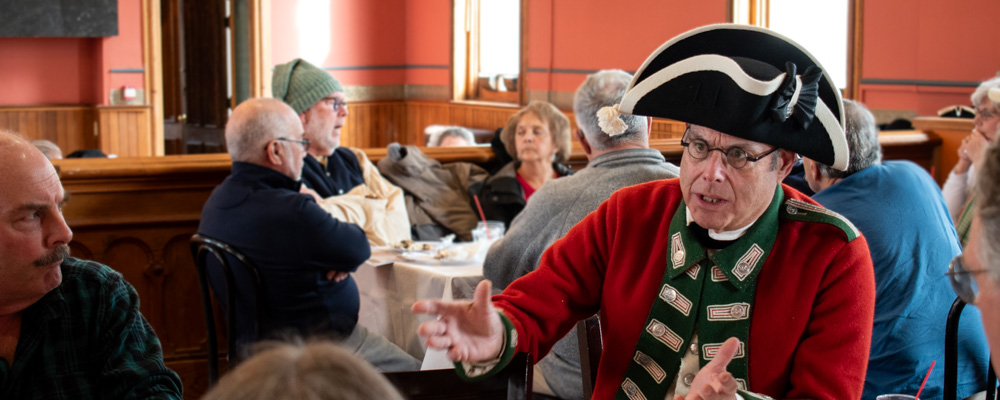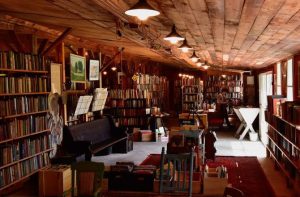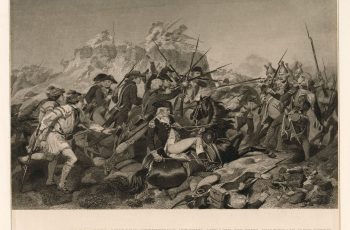Washington County, New York, may not be the first place that comes to mind when one thinks of Black history. However, this rural county, located in the northeastern part of the state, features a rich and complex African American legacy that’s often been overlooked.
In honor of Black History Month, let’s explore the many ways African Americans have helped shape this part of the upper Hudson Valley into the welcoming “melting pot” community it is today.
Black History Throughout the Ages in Washington County, NY
Like much of America, Washington County, NY’s black history stretches further back than the roots of our nation. Over time, much of this history was lost, and what we know today was pieced together by dedicated historians. Read on to learn a bit about what they’ve found.
Early Settlers
There are many stories of black history in Washington County that have long been hidden in plain sight. For example, research has shown that several black families lived in the county nearly from the beginning! This group mainly consisted of enslaved farmers and laborers who played an important role in the county’s development.
The first African-Americans in Washington County came long before the French and Indian War or Revolutionary War; largely, they were chattel slaves of Dutch settlers. Early census records show the enslaved were often given Dutch surnames such as Deridder, Schuyler, Van Buren, or Winnie. One notable example is Peter Stivers, who was born around 1802 in Albany County, and then brought as a child to Washington County by one of the area’s first settlers.
Early in New York’s history, as the towns of Fort Orange (now Albany) and New Amsterdam (New York City) were experiencing a period of rapid growth, so did this region’s slave trade. As prominent families were granted large tracts of land to begin to develop New York’s northern frontier (including Philip Skene, John McCrea, and William Duer), settlers moving to this region brought along enslaved African people to supplement these development efforts. Nearby Schagticoke was established as a plantation, accelerating the growth of the area’s enslaved population.
Revolutionary Era
As the Revolution grew nearer, tensions began to grow throughout the country and black populations began to move in and out of the region with more frequency. Anglo settlers brought enslaved workers along with them, where they often lived, worked, and died side-by-side. This was the case in Argyle, NY’s Allen Family Massacre when slaves Abram, Sarah, and Tom were murdered alongside John Allen and his family by natives attached to John Burgoyne’s Saratoga Campaign.
Additionally, other towns across the area formed their significant populations of enslaved people, including Skenesborough (now Whitehall), Easton, and Salem. One young black girl named Sylvia (rumored to be the daughter of Philip Skene) was captured and taken to Salem, where she lived to be over 80 years old.
Often, even as settlements were abandoned or enslavers went off to fight in the wars, those recently freed from bondage remained. After all, who wouldn’t be reluctant to venture into the wilderness during the heightened period of bloodshed leading up to the Revolution?
Abolitionists and the Underground Railroad
As the Quaker religion began to rise and the issue of slavery became a controversial topic in many circles, the idea of freedom for all began to take root across Washington County. Freedom seekers continued to escape the draconian laws that ensnared them, and the Underground Railroad began to grow. An often-forgotten section of it stretches through the entire length of our large county, and onward to the Canadian border.
If you’d like to read more about the many local residents who helped conduct people along this secret thru-way, read our article on historic Underground Railroad sites you can still see today. Or, read a brief history of women’s suffrage in Washington County, which includes the influential abolitionist and women’s rights advocate, Susan B. Anthony.
One of the sites you can still see along the Underground Railroad Stops in the Union Village walking tour is the Free Congregational Church. This historic building was founded by abolitionists and built to hold up to 500 guests, eager to hear some of the era’s most famous speakers, including Frederick Douglass and William Lloyd Garrison.
Exploring Black History Through Local Figures
Black history is not just shaped by events, but by the people who lived them. Below, we’ll briefly explore the lives of three extraordinary black men who helped turn Washington County, NY into a home for people from all walks of life.

Pictured: Engraving of Solomon Northup from his autobiography
Solomon Northup
Arguably one of the most famous African-Americans in early American history, Solomon Northup was born a free man around 1808 in New York State. He was a professional violinist, farmer, and landowner in Washington County, NY, and he and his wife Anne Hampton both briefly resided in the boarding house now known as the Old Fort House Museum. But what made Northup famous is what happened after the family moved to nearby Saratoga Springs, NY.
In 1841, Solomon was offered a job as a traveling musician and ventured to Washington, D.C. – where slavery was legal. There, he was kidnapped and sold, the tale becoming the basis of his later autobiographical narrative: ‘Twelve Years a Slave: Narrative of Solomon Northup, a Citizen of New York, Kidnapped in Washington City in 1841, and Rescued in 1853, from a Cotton Plantation near the Red River in Louisiana (1853).’
In his first year of freedom after his harrowing ordeal, Northup wrote his book. Afterward, he traveled extensively to argue for abolition, giving over two dozen speeches throughout the Northeast to help build a case against slavery.

Pictured: Frontispiece of 1837’s Sketches of the Life and Character of the Rev. Lemuel Haynes, A.M.
Lemuel Haynes
A leader of his time, Lemuel Haynes not only served as a Patriot during the American Revolution but later became the first ordained African-American minister in the United States, as well as the first Black man in America to receive an honorary college degree.
After being abandoned by his mixed-race parents, Haynes was eventually freed from his life as an indentured servant once he reached the age of 21. Later, he joined the local farmers’ militia, which participated in the siege of Boston. Notably, Haynes also became one of three African-American men in Ethan Allen’s famous Green Mountain Boys.
After the war, Haynes furthered his theological studies and became licensed to preach in November of 1780, where he was assigned to Middle Granville, NY. There, he became the first African American minister of an all-white congregation!
After Granville, Haynes served in Rutland, VT, where he wrote essays and gave sermons opposing slavery and oppression. Toward the end of his career, Haynes returned to South Granville Congregational Church to serve eleven more years before he passed at the age of 80. His home in Granville, while still in use as a private residence, is listed on both New York State and the National Registry of Historic Landmarks.

Pictured: John Henry and what’s believed to be Lt. William Boyd (left) in front of Henry’s blacksmith shop in Whitehall, NY
John Henry and Emma Baltimore
The deeply entwined Henry and Baltimore families of New York’s Capital Region tell a tale of one of the most tumultuous times in our nation’s history. From a family photo album dating back to the Victorian era, local historians have gained insight into the fascinating past of this influential abolitionist family.
After working for the University of Virginia for 20 long years as a slave, John Henry made his way to Whitehall, NY after the Civil War was over. He rode into town alongside Lt. William Boyd, son of a local congressman, an escapee of a southern prisoner of war camp, and “liberator of the slaves.” Eventually, Henry became a blacksmith in the area, opening a successful shop that employed up to five people. Through his association with another Whitehall resident, “cloth scourer” George Baltimore, John met and married George’s daughter, Emma.
The Baltimores of Troy, NY
The Baltimores were a well-respected African American family from Troy with deep ties to the Underground Railroad. In fact, Emma’s uncle Peter Baltimore owned a barber shop in Troy that was a documented location involved with the UGRR. Another of her family members, Garnet Baltimore, “became the first black graduate of Rensselaer Polytechnic Institute (RPI) in Troy. He worked on bridges, railroads, canals, and waterways all over the state, including the difficult “mud lock” on the Oswego Canal, where he developed a system to test cement that was adopted as standard by the state of New York.”
While John Henry, Emma, and their two surviving children led an active social life centered around the Methodist Church, their relationships stretched much further. In the album, there’s a photo from Worcester, Massachusetts of Walter N. Cosburn. He was best known for opposing a bill suggesting the U.S. raise an army of “colored men” overseen by white officers. Within, you’ll also find the photo of Stanislau Kostka Govern, an immigrant from St. Kitts who eventually came to manage one of America’s early black baseball teams.
Altogether, recent research has unveiled the life of this self-made upper middle-class family, both deeply involved with and beloved by their local community.
Black History Hidden in Plain Sight
As we look back on the past in celebration of our nation’s 250th anniversary, we’ve teamed up with local historians to carefully examine the threads that make up our county’s contributions to the Great American Tapestry that binds us all together. From the pre-colonial era to modern times, one thing has become clear: Black history is American history, and these stories of struggle, resilience, and achievement deserve to be remembered.
Whether you visit Washington County to marvel at our historic architecture, see transportation methods through the ages, or learn more about our role as one of the most-used warpaths, remember that for every story told, there are hundreds more just waiting to be discovered.
Want to know more about Washington County, New York?
If you’re looking for new adventures, you’ll find find many unforgettable experiences among the rolling hills and winding rivers of Washington County, NY! Dive deeper into history at our memorable museums, or relax and check out our scenic golf courses, world-class wineries, and unique artistic excursions.
Of course, you’ll also find welcoming places to stay, from unique historic stays to traditional bed & breakfasts. You may also want to check out our hiking, fishing, learning, and shopping opportunities. Either way, you’ll love exploring the incredible variety of experiences Washington County has to offer!








